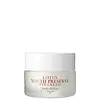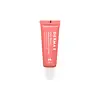What's inside
What's inside
 Key Ingredients
Key Ingredients

 Benefits
Benefits

 Concerns
Concerns

 Ingredients Side-by-side
Ingredients Side-by-side

Water
Skin ConditioningGlycerin
HumectantIsostearyl Isostearate
EmollientPropanediol
SolventSqualane
EmollientCetyl Alcohol
EmollientPotassium Cetyl Phosphate
EmulsifyingPentylene Glycol
Skin ConditioningC10-18 Triglycerides
EmollientBoron Nitride
AbsorbentGlyceryl Stearate
EmollientPolyglycerin-3
HumectantNelumbo Nucifera Extract
Skin ConditioningAesculus Hippocastanum Extract
AntioxidantCitrus Limon Peel Oil
MaskingCucumis Sativus Fruit Extract
EmollientTocopherol
AntioxidantFructose
HumectantEthylene/Acrylic Acid Copolymer
Emulsion StabilisingBis-Diglyceryl Polyacyladipate-2
EmollientBehenyl Alcohol
EmollientDimethicone
EmollientCarbomer
Emulsion StabilisingSodium Polyacrylate
AbsorbentXanthan Gum
EmulsifyingSodium Citrate
BufferingCaprylic/Capric Triglyceride
MaskingSodium Hyaluronate
HumectantCitric Acid
BufferingSodium Hydroxide
BufferingAdenosine
Skin ConditioningBiosaccharide Gum-2
Skin ConditioningSodium Metabisulfite
AntioxidantPoloxamer 338
EmulsifyingSilica
AbrasiveTetrasodium EDTA
Chlorphenesin
AntimicrobialPotassium Sorbate
PreservativeSodium Benzoate
MaskingLimonene
PerfumingCitral
PerfumingWater, Glycerin, Isostearyl Isostearate, Propanediol, Squalane, Cetyl Alcohol, Potassium Cetyl Phosphate, Pentylene Glycol, C10-18 Triglycerides, Boron Nitride, Glyceryl Stearate, Polyglycerin-3, Nelumbo Nucifera Extract, Aesculus Hippocastanum Extract, Citrus Limon Peel Oil, Cucumis Sativus Fruit Extract, Tocopherol, Fructose, Ethylene/Acrylic Acid Copolymer, Bis-Diglyceryl Polyacyladipate-2, Behenyl Alcohol, Dimethicone, Carbomer, Sodium Polyacrylate, Xanthan Gum, Sodium Citrate, Caprylic/Capric Triglyceride, Sodium Hyaluronate, Citric Acid, Sodium Hydroxide, Adenosine, Biosaccharide Gum-2, Sodium Metabisulfite, Poloxamer 338, Silica, Tetrasodium EDTA, Chlorphenesin, Potassium Sorbate, Sodium Benzoate, Limonene, Citral
Water
Skin ConditioningCaprylic/Capric Triglyceride
MaskingGlycerin
HumectantCetyl Alcohol
EmollientDimethicone
EmollientGlyceryl Stearate Citrate
EmollientGlyceryl Stearate
EmollientMethyl Gluceth-20
HumectantButyrospermum Parkii Butter
Skin ConditioningSimmondsia Chinensis Seed Oil
EmollientCentella Asiatica Extract
CleansingInulin
Skin ConditioningGanoderma Lucidum Extract
Skin ProtectingLactobacillus/Panax Ginseng Root Extract Ferment Filtrate
Skin ConditioningXanthophylls
Skin ConditioningCucumis Sativus Fruit Extract
EmollientPanax Quinquefolius Root Extract
AstringentAphanizomenon Flos-Aquae Powder
EmollientCamellia Sinensis Leaf Extract
AntimicrobialAesculus Hippocastanum Seed Extract
Skin ConditioningSodium Hyaluronate
HumectantPanthenol
Skin ConditioningAllantoin
Skin ConditioningHydrolyzed Rice Protein
Skin ConditioningCaffeine
Skin ConditioningAscorbyl Palmitate
AntioxidantTocopheryl Acetate
AntioxidantDiisostearoyl Polyglyceryl-3 Dimer Dilinoleate
EmollientSucrose
HumectantTapioca Starch
Tin Oxide
AbrasiveMica
Cosmetic ColorantTitanium Dioxide
Cosmetic ColorantPolyethylene
AbrasiveXanthan Gum
EmulsifyingSodium Hydroxide
BufferingPotassium Sorbate
PreservativeEthylhexylglycerin
Skin ConditioningPhenoxyethanol
PreservativeWater, Caprylic/Capric Triglyceride, Glycerin, Cetyl Alcohol, Dimethicone, Glyceryl Stearate Citrate, Glyceryl Stearate, Methyl Gluceth-20, Butyrospermum Parkii Butter, Simmondsia Chinensis Seed Oil, Centella Asiatica Extract, Inulin, Ganoderma Lucidum Extract, Lactobacillus/Panax Ginseng Root Extract Ferment Filtrate, Xanthophylls, Cucumis Sativus Fruit Extract, Panax Quinquefolius Root Extract, Aphanizomenon Flos-Aquae Powder, Camellia Sinensis Leaf Extract, Aesculus Hippocastanum Seed Extract, Sodium Hyaluronate, Panthenol, Allantoin, Hydrolyzed Rice Protein, Caffeine, Ascorbyl Palmitate, Tocopheryl Acetate, Diisostearoyl Polyglyceryl-3 Dimer Dilinoleate, Sucrose, Tapioca Starch, Tin Oxide, Mica, Titanium Dioxide, Polyethylene, Xanthan Gum, Sodium Hydroxide, Potassium Sorbate, Ethylhexylglycerin, Phenoxyethanol
Ingredients Explained
These ingredients are found in both products.
Ingredients higher up in an ingredient list are typically present in a larger amount.
This ingredient is an emollient, solvent, and texture enhancer. It is considered a skin-softener by helping the skin prevent moisture loss.
It helps thicken a product's formula and makes it easier to spread by dissolving clumping compounds.
Caprylic Triglyceride is made by combining glycerin with coconut oil, forming a clear liquid.
While there is an assumption Caprylic Triglyceride can clog pores due to it being derived from coconut oil, there is no research supporting this.
Learn more about Caprylic/Capric TriglycerideCetyl Alcohol is a fatty alcohol. Fatty Alcohols are most often used as an emollient or to thicken a product.
Its main roles are:
Though it has "alcohol" in the name, it is not related to denatured alcohol or ethyl alcohol.
The FDA allows products labeled "alcohol-free" to have fatty alcohols.
Learn more about Cetyl AlcoholThis extract comes from cucumber. Cucumbers are mostly made up of water (95%), and the other 5% is composed of: vitamin C, caffeic acid, fatty acids, amino acids, and other minerals.
Cucumbers have anti-inflammatory, barrier repair, and hydrating properties.
They contain shikimate dehydrigenase, an enzyme shown to help reduce inflammation and soothe the skin.
The amino acids found in cucumbers help nourish our skin's natural acid mantle (it's an important part of our skin barrier). This slightly acidic film acts as a barrier to protect us from bacteria, viruses, and other contaminants.
Unless you have an allergy to cucumbers, this is generally a non-irritating ingredient.
Fun fact: Cucumis Sativus is native to South Asia and can now be found on every continent.
Learn more about Cucumis Sativus Fruit ExtractDimethicone is a type of synthetic silicone created from natural materials such as quartz.
What it does:
Dimethicone comes in different viscosities:
Depending on the viscosity, dimethicone has different properties.
Ingredients lists don't always show which type is used, so we recommend reaching out to the brand if you have questions about the viscosity.
This ingredient is unlikely to cause irritation because it does not get absorbed into skin. However, people with silicone allergies should be careful about using this ingredient.
Note: Dimethicone may contribute to pilling. This is because it is not oil or water soluble, so pilling may occur when layered with products. When mixed with heavy oils in a formula, the outcome is also quite greasy.
Learn more about DimethiconeGlycerin is already naturally found in your skin. It helps moisturize and protect your skin.
A study from 2016 found glycerin to be more effective as a humectant than AHAs and hyaluronic acid.
As a humectant, it helps the skin stay hydrated by pulling moisture to your skin. The low molecular weight of glycerin allows it to pull moisture into the deeper layers of your skin.
Hydrated skin improves your skin barrier; Your skin barrier helps protect against irritants and bacteria.
Glycerin has also been found to have antimicrobial and antiviral properties. Due to these properties, glycerin is often used in wound and burn treatments.
In cosmetics, glycerin is usually derived from plants such as soybean or palm. However, it can also be sourced from animals, such as tallow or animal fat.
This ingredient is organic, colorless, odorless, and non-toxic.
Glycerin is the name for this ingredient in American English. British English uses Glycerol/Glycerine.
Learn more about GlycerinGlyceryl Stearate is a mix of glycerin and stearic acid.
It is used to stabilize the mixing of water and oil ingredients. By preventing these ingredients from separating, it can help elongate shelf life. It can also help thicken the product's texture.
As an emollient, it helps soften skin and supports barrier-replenishing ingredients.
In cosmetics, Glyceryl Stearate is often made from vegetable oils or synthetically produced.
This ingredient may not be fungal-acne safe
Fun fact: The human body also creates Glyceryl Stearate naturally.
Learn more about Glyceryl StearatePotassium Sorbate is a preservative used to prevent yeast and mold in products. It is commonly found in both cosmetic and food products.
This ingredient comes from potassium salt derived from sorbic acid. Sorbic acid is a natural antibiotic and effective against fungus.
Both potassium sorbate and sorbic acid can be found in baked goods, cheeses, dried meats, dried fruit, ice cream, pickles, wine, yogurt, and more.
You'll often find this ingredient used with other preservatives.
Learn more about Potassium SorbateSodium Hyaluronate is hyaluronic acid's salt form. It is commonly derived from the sodium salt of hyaluronic acid.
Like hyaluronic acid, it is great at holding water and acts as a humectant. This makes it a great skin hydrating ingredient.
Sodium Hyaluronate is naturally occurring in our bodies and is mostly found in eye fluid and joints.
These are some other common types of Hyaluronic Acid:
Learn more about Sodium HyaluronateSodium Hydroxide is also known as lye or caustic soda. It is used to adjust the pH of products; many ingredients require a specific pH to be effective.
In small amounts, sodium hydroxide is considered safe to use. However, large amounts may cause chemical burns due to its high alkaline.
Your skin has a natural pH and acid mantle. This acid mantle helps prevent harmful bacteria from breaking through. The acid mantle also helps keep your skin hydrated.
"Alkaline" refers to a high pH level. A low pH level would be considered acidic.
Learn more about Sodium HydroxideWater. It's the most common cosmetic ingredient of all. You'll usually see it at the top of ingredient lists, meaning that it makes up the largest part of the product.
So why is it so popular? Water most often acts as a solvent - this means that it helps dissolve other ingredients into the formulation.
You'll also recognize water as that liquid we all need to stay alive. If you see this, drink a glass of water. Stay hydrated!
Learn more about WaterXanthan gum is used as a stabilizer and thickener within cosmetic products. It helps give products a sticky, thick feeling - preventing them from being too runny.
On the technical side of things, xanthan gum is a polysaccharide - a combination consisting of multiple sugar molecules bonded together.
Xanthan gum is a pretty common and great ingredient. It is a natural, non-toxic, non-irritating ingredient that is also commonly used in food products.
Learn more about Xanthan Gum